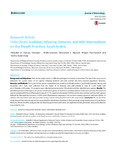Ticks (Acari: Ixodidae) Infesting Domestic and Wild Mammalians on the Riyadh Province, Saudi Arabia
| dc.contributor.author | Alanazi, A | |
| dc.contributor.author | Al-Mohamed, H | |
| dc.contributor.author | Alysousif, M | |
| dc.contributor.author | Puschendorf, Robert | |
| dc.contributor.author | Abdel-Shafy, S | |
| dc.date.accessioned | 2018-09-05T14:28:43Z | |
| dc.date.issued | 2018-09-04 | |
| dc.identifier.issn | 1812-5670 | |
| dc.identifier.issn | 1812-5689 | |
| dc.identifier.uri | http://hdl.handle.net/10026.1/12229 | |
| dc.description.abstract |
Background and Objectives: Ticks are the major vectors of different pathogens to humans and animals. The aim of this study was to determine the current status of tick species infesting domestic and wild animals and their seasonal population dynamics. Materials and Methods: This survey on tick species composition was carried out in Riyadh province, Saudi Arabia between January and December, 2017. Ticks were collected from the bodies of 18 domestic and wild animals. A total of 11,587 ixodid ticks (6,247 females; 4,585 males; 755 nymphs) were collected and preserved in 70% alcohol and then identified as to species. Results: The identified specimens belonged to ten species, including two genera of Hyalomma and Rhipicephalus. In domestic animals, the Hyalomma species comprised 68.3% and Rhipicephalus species 31.7%. Hyalomma dromedarii (39.9%) was the most common and abundant species, followed by Rhipicephalus turanicus (34.9%), while Rhipicephalus sanguineus was the most common species in wild hosts (83.0%). In addition, tick populations were most prevalent during summer and spring (36.0 and 31.6%, respectively). Conclusion: The results of this study showed that some tick species have expanded their distribution elsewhere to their previously recognised locations in Saudi Arabia. Moreover, the results of this study provide new data that government authorities can implement to take prevention measures for diseases transmitted by ticks. | |
| dc.format.extent | 75-82 | |
| dc.language.iso | en | |
| dc.publisher | Academic Journals, New York | |
| dc.subject | Infectious Diseases | |
| dc.title | Ticks (Acari: Ixodidae) Infesting Domestic and Wild Mammalians on the Riyadh Province, Saudi Arabia | |
| dc.type | journal-article | |
| dc.type | Journal Article | |
| plymouth.issue | 2 | |
| plymouth.volume | 15 | |
| plymouth.publication-status | Published | |
| plymouth.journal | Journal of Entomology | |
| dc.identifier.doi | 10.3923/je.2018. | |
| plymouth.organisational-group | /Plymouth | |
| plymouth.organisational-group | /Plymouth/Faculty of Science and Engineering | |
| plymouth.organisational-group | /Plymouth/Faculty of Science and Engineering/School of Biological and Marine Sciences | |
| plymouth.organisational-group | /Plymouth/REF 2021 Researchers by UoA | |
| plymouth.organisational-group | /Plymouth/REF 2021 Researchers by UoA/UoA06 Agriculture, Veterinary and Food Science | |
| plymouth.organisational-group | /Plymouth/Users by role | |
| plymouth.organisational-group | /Plymouth/Users by role/Academics | |
| dcterms.dateAccepted | 2018-09-04 | |
| dc.rights.embargodate | 2018-9-8 | |
| dc.identifier.eissn | 1812-5689 | |
| dc.rights.embargoperiod | Not known | |
| rioxxterms.versionofrecord | 10.3923/je.2018. | |
| rioxxterms.licenseref.uri | http://www.rioxx.net/licenses/all-rights-reserved | |
| rioxxterms.licenseref.startdate | 2018-09-04 | |
| rioxxterms.type | Journal Article/Review |


